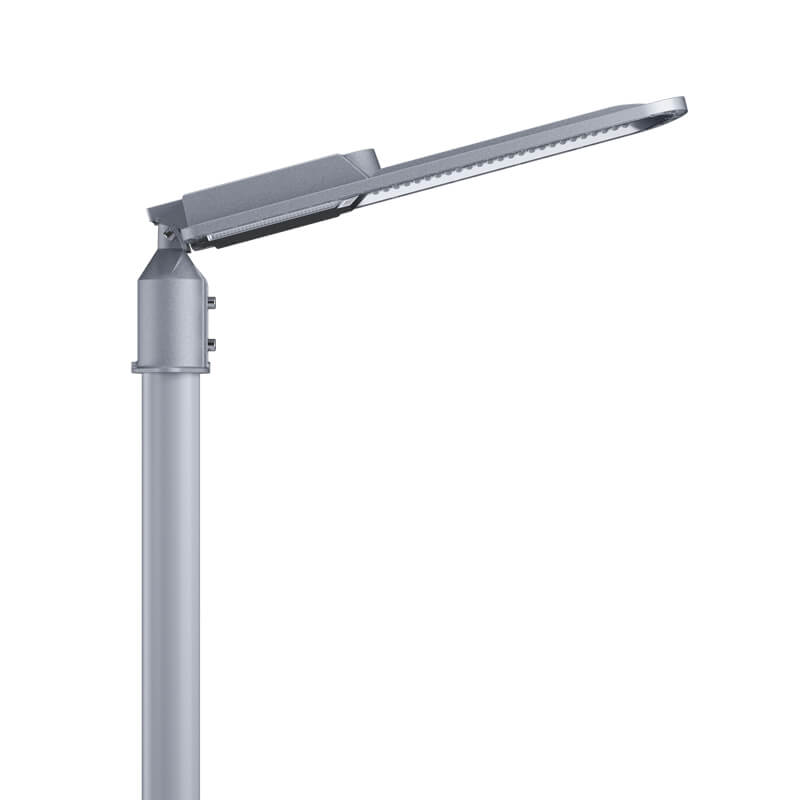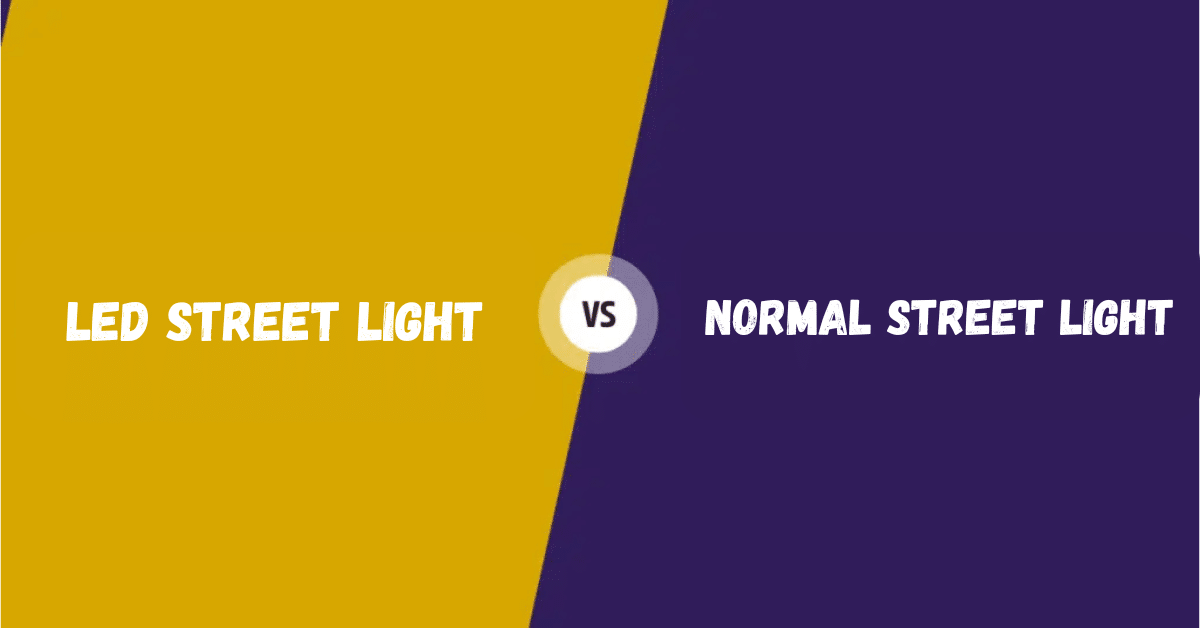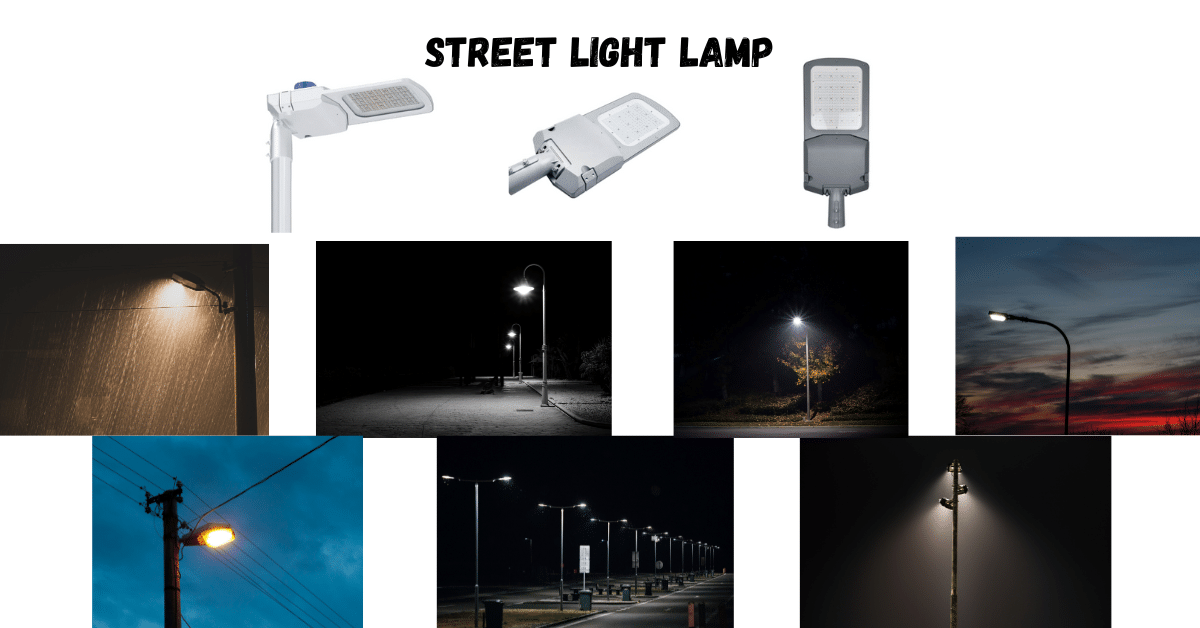Home » LED Street Lights: Wholesale Custom Manufacturer In China
LED Street Lights: Wholesale Custom Manufacturer In China
Murcu has the best and most complete street lighting solutions, with long-lasting power supply and sturdy materials for the outside. The Elitebox Shoebox Light, Street Light Lamp, LED Street Light, and Outdoor Street Light are all part of our LED lighting line. Each solution is made to give the best light and dependability for cities. Please don’t hesitate to get in touch with our team for one-of-a-kind solutions made just for you.
Types of LED Street Lights From Murcu
Wholesale Custom LED Street Lights Manufacturer In China - Murcu
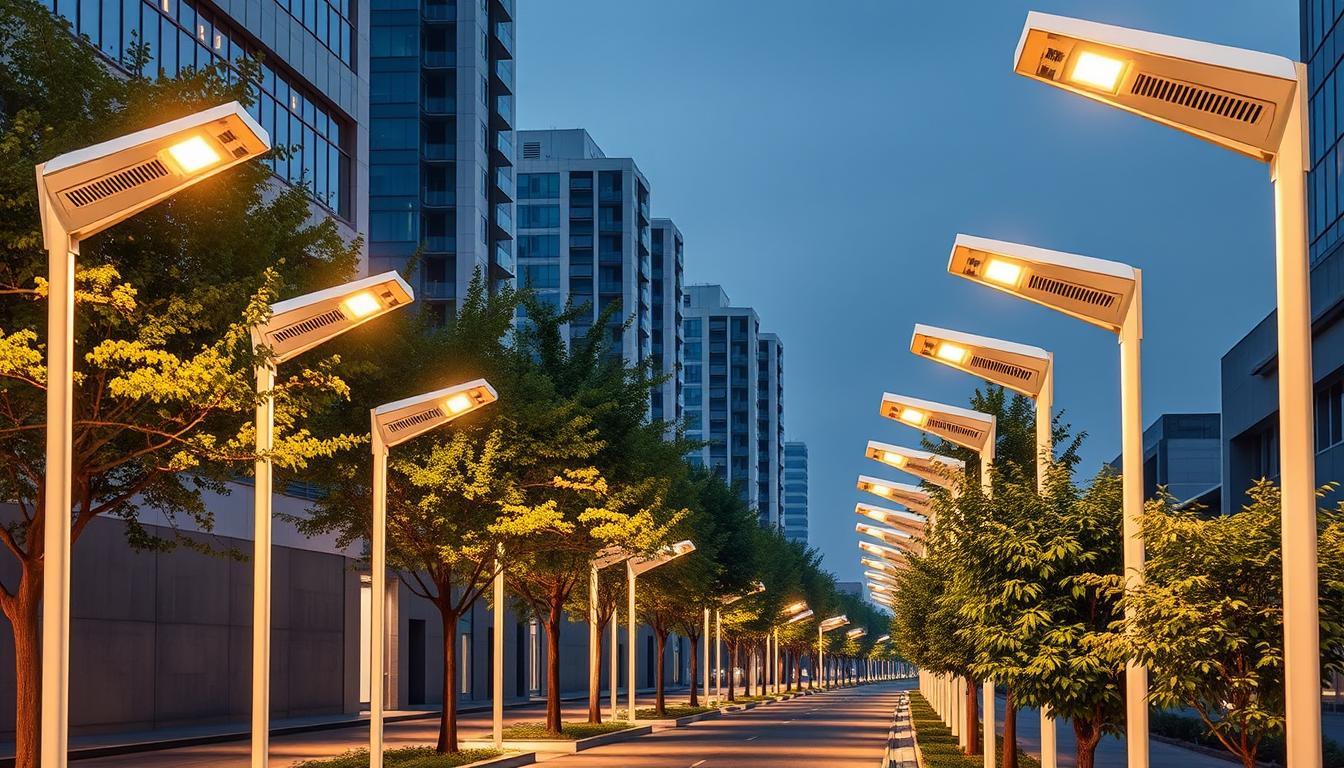
Is the future of city infrastructure going to be energy-efficient lighting? Cities all throughout the world want to lower their carbon footprints. More and more people are choosing LED lights for street illumination. We look at how China’s manufacturers are leading the way in making LED street lights for both individuals and businesses.
There is a growing need for green growth in cities. People all across the world are buying LED street lights because they last a long time and use less energy. China is a key part of this change because it makes a lot of various LED street lights that may be used in different cities.
Important Points
- China is one of the biggest makers of LED street lights, and they offer both custom and bulk orders.
- One of the best things about LED street lights is that they save energy and last a long time.
- More and more people are using solar LED street lights since they are good for the environment.
- Custom LED street lighting can satisfy a variety of applications in metropolitan areas.
- COB LED modules make street lights work better.
Introduction to LED Street Lighting
LED street lights are an important part of making cities use less energy. Cities require reliable and eco-friendly lighting as they grow. This is more critical than ever.
Purpose of LED Street Lighting
LED street lights are meant to light up public spaces well while using less energy. They last longer and are cheaper to keep up than old lights.
- Better use of energy
- Longer longevity compared to traditional lighting
- Lower costs for upkeep
- Better lighting makes things safer.
Advantages of LEDs vs Conventional Lighting (HPS, CFL, etc.)
In a lot of respects, LEDs are better than previous lights like HPS and CFL. Here are some of the primary benefits:
- LEDs are more energy-efficient since they utilize less power.
- Longer Lifespan: LEDs can last up to 50,000 hours, while HPS and CFL lights last between 10,000 and 20,000 hours.
- Instant On/Off: LEDs turn on immediately away, however HPS lights take a while to turn on.
- Design Flexibility: You can make LEDs in a wide range of colors and shapes to meet your demands.
LED solar street lighting use both solar panels and LEDs. They are a wonderful solution for places that don’t have power.
Definitions and Important Terms
Knowing the terms of LED street lighting will help you make good decisions. Here are some of the most important ones:
- Lumen Output: This tells you how much light a source gives off.
- Color Temperature: This tells you the color of the light, from warm to cool, in Kelvin (K).
- Lumen Depreciation: How the brightness of light changes with time, which affects how well it works.
- LED Driver: It controls the power going to the LEDs to make sure they perform well and consume energy correctly.
Cities may pick better lighting if they know what these words mean and how LED lighting might help. This makes the streets greener and more efficient.
Standards and References for Street Lighting
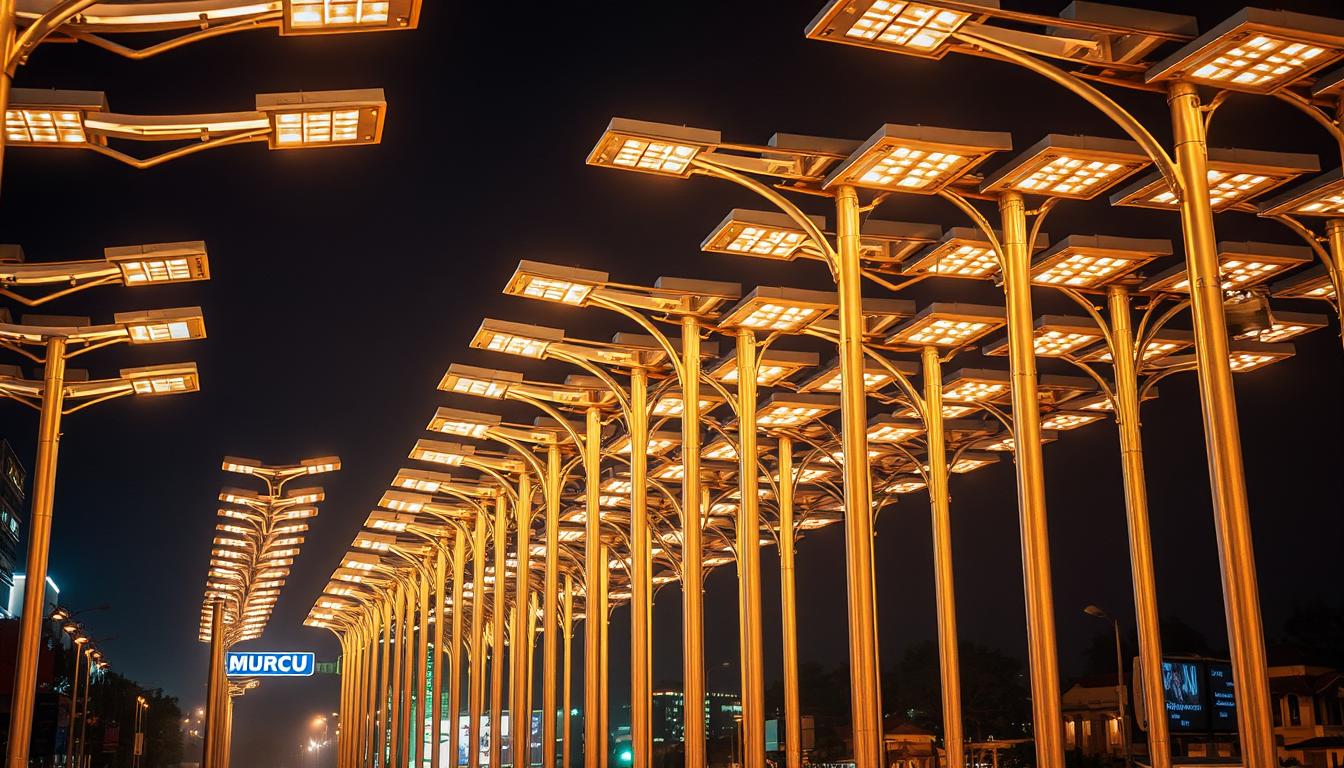
Standards and standards are very important while making and putting up LED street lighting. They check that these lights are safe, perform well, and are of decent quality.
International & National Standards
There are many worldwide and national standards that tell people how to make and install LED street lights. For instance, the International Electrotechnical Commission (IEC) establishes standards for all electrical products around the world, including LED lights. The American National Standards Institute (ANSI) and the Illuminating Engineering Society (IES) provide rules for street lighting in the United States. To sell their products over the world and respect local restrictions, makers need to fulfill these requirements.
Some important international standards are:
- Luminaires according to IEC 60598
- IEC 62031: LED modules for illumination in general
- IEC 62722: Performance of luminaires
City or Municipal Specifications
Local governments also have their own policies about LED street lights. These regulations might say how high the poles should be, what kind of light to use, and how the light should spread. For example, a city might desire LED lights that can be dimmed or that operate with smart controllers. To make things that work for people in their area, makers need to know these criteria.
“Cities are looking for LED street lights that not only meet national standards but also have extra features like adaptive lighting and energy efficiency.”
Guidelines for Design and Inspection
It is highly necessary to have design documents and inspection instructions for putting up and taking care of LED street lighting. They explain in full how to plan street lighting systems, including where to put poles and how to wire them. They also help make sure that the lights are put in the appropriate way. Regular checks can find problems early, which keeps the lights running properly for a long period.
By following these rules, manufacturers and municipal governments may design LED street lighting systems that work well, are safe, and are dependable.
Design Criteria and Requirements for LED Street Lights
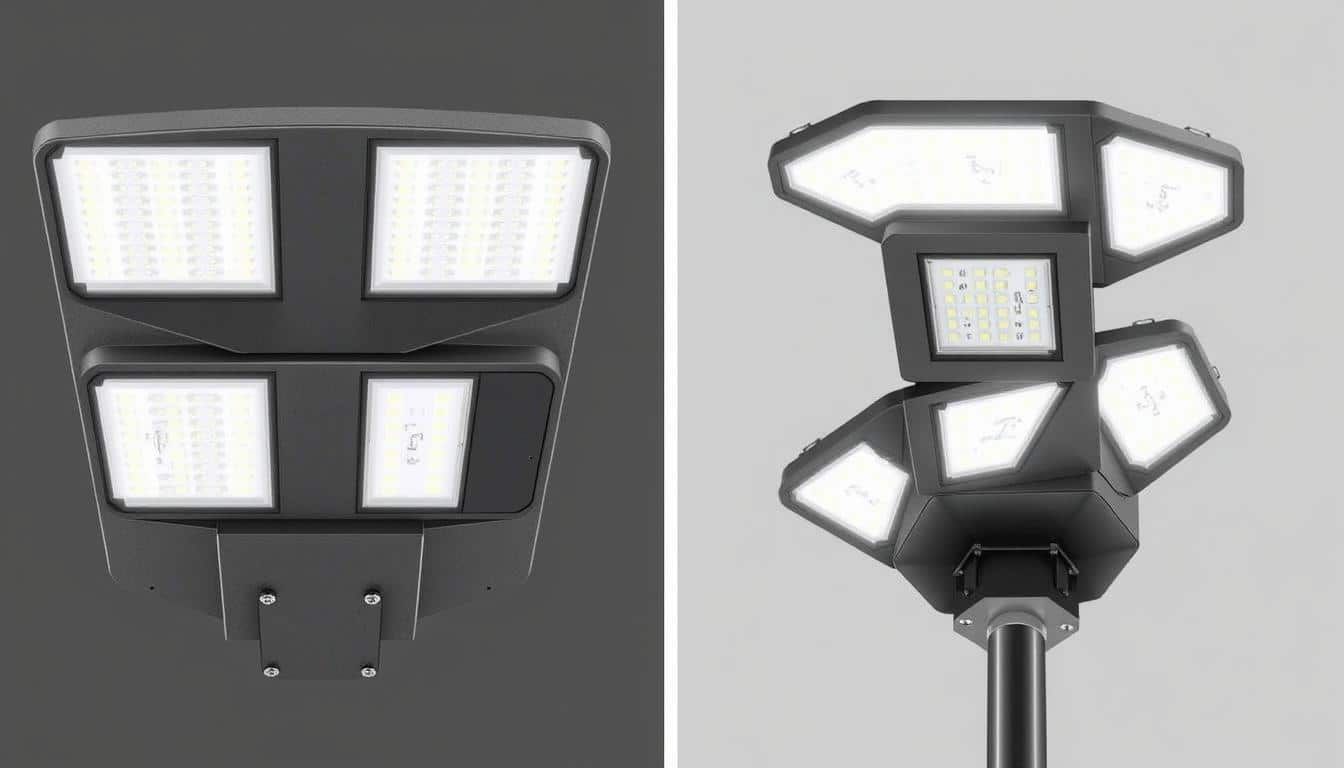
Following certain design criteria is the best way to get the most out of LED street lights. It’s necessary to thoroughly consider the sorts of poles and wiring that are needed. This makes sure that the lights perform well and endure a long time.
General Street Lighting Design Principles
Good street lighting design is safe, saves energy, and is good for the environment. It wants to make sure that areas are well-lit, that there isn’t too much glare, and that light is spread out evenly.
Designers need to think about how many people go through the region, how much traffic there is, and the surroundings. This helps make lights that perform properly and are good for the environment.
Street Light Placement & Exceptions
It is very important to put street lights in the appropriate places so that the light is even and there are no dark spots. The design needs to think about the shape of the road, where people cross, and other crucial places.
Lighting needs to be both practical and nice to look at in certain settings, including historic areas. This balance is really important.
Pole Types, Heights & Mounting Standards
For street lights to work well and survive a long time, it’s necessary to choose the correct type of pole and height. Different poles are utilized for different types of lighting and weather.
The height and location of the lights are also quite important. It keeps the light from shining too brightly and makes sure it travels where it has to go.
Wiring, Conduits & Circuit Clearance
The wiring and conduit of LED street lights must be safe and work well. To stay safe and endure a long time, they have to follow the laws for electricity in their area.
Clearance standards are also vital for keeping the system running smoothly and avoiding electrical difficulties. Good clearance keeps the electrical circuit safe and lowers the chance of a problem.
| Design Element | Description | Standard Requirement |
|---|---|---|
| Pole Height | Determines the elevation of the light source | Typically ranges from 8 to 12 meters |
| Mounting Type | Affects the orientation and stability of the fixture | Should be compatible with the pole type |
| Wiring Type | Influences the safety and efficiency of the electrical supply | Must comply with local electrical codes |
Performance Requirements for Street Lights
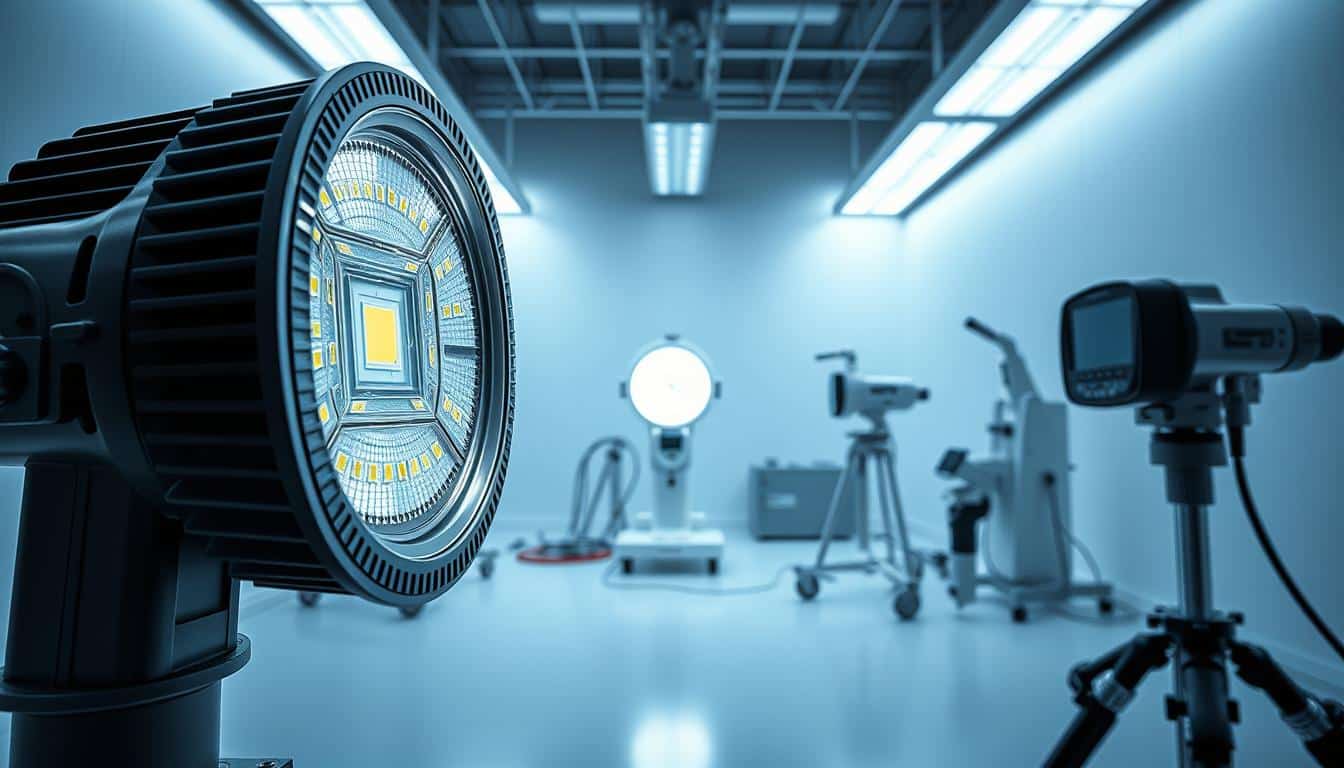
There are a few important things that LED street lighting need to do. These make sure they light up the area well, don’t consume too much power, and last a long time. These rules assist keep people safe and lower the cost of maintenance.
Standards for Light Distribution and Photometry
Photometric requirements must be followed by LED street lights. Good light distribution makes ensuring that the road is well-lit. This makes things easier for vehicles and pedestrians to see by cutting down on shadows.
Tables of Lumen Output and Equivalency
The lumen output tells you how bright an LED street light is. LED lights are compared to older types of illumination in equivalency tables. This makes it easy to find the correct replacements.
| Traditional Lighting | Lumen Output | LED Equivalent |
|---|---|---|
| 100W HPS | 9500 lumens | 120W LED |
| 150W HPS | 14000 lumens | 180W LED |
| 250W HPS | 28000 lumens | 300W LED |
Requirements for Uniformity, Glare, and Cutoff
Uniformity means that the light is spread out uniformly. Glare control keeps you from getting dazzled, which might harm your eyes. Cutoff criteria help keep light pollution down by making sure light goes where it’s required.
Consistent illumination makes roads safer by making it easier to see.
Reliability, Life Expectancy, and Lumen Depreciation
The life expectancy and lumen degradation of an LED street light tell you how long it will last. It also important how dependable it is. It changes how often it needs to be maintained and how much it costs overall.
- Most of the time, life expectancy is measured in hours.
- Lumen depreciation is when the light gets dimmer over time.
- How well the light is made and how it is used affect how reliable it is.
Electrical and Mechanical Requirements for LED Street Lighting
To get the most out of LED street lights and make them last as long as possible, you need to know what their electrical and mechanical needs are. These demands are important to make sure the lights function well and last a long time.
Power Supply & Voltage Considerations
When designing LED street lights, the power supply and voltage are particularly crucial. These lights need to work at a specified voltage level. To avoid damage or low efficiency, you need to make sure that the power supply is right for the LED.
LED street lighting can be damaged by fluctuations in voltage. So, it’s important to employ ways that make voltage changes less harmful.
Control Gear and LED Drivers
LED street lights need LED drivers and control gear to perform properly. They control the power to the LEDs, which keeps them working properly and for longer.
The kind of LED drivers used can have a big effect on how well and reliably the street lights work. Good drivers can help things run better and need less maintenance.
Protection against Surges
Surge protection is a very important part of designing LED street lights. Lightning strikes and disturbances in the electrical grid might cause surges that can damage the lights.
Surge protection systems can keep LEDs and other parts safe from these surges. This makes sure the system works well and lasts a long time.
“The importance of surge protection cannot be overstated, as it directly impacts the durability and performance of LED street lighting systems.” Industry Expert
Mechanical Durability (Wind, Vibration, Impact)
The ability of LED street lights to handle diverse weather conditions depends on their mechanical robustness. This includes things like wind, vibration, and impact.
- To keep the lights in place, they need to be able to resist the wind.
- Vibration resistance helps the lighting system last longer.
- To keep the LEDs and other elements safe, they need to be able to resist impact.
Taking these things into account when designing LED street lights might make them last longer and work better.
Materials and Components of LED Street Lights
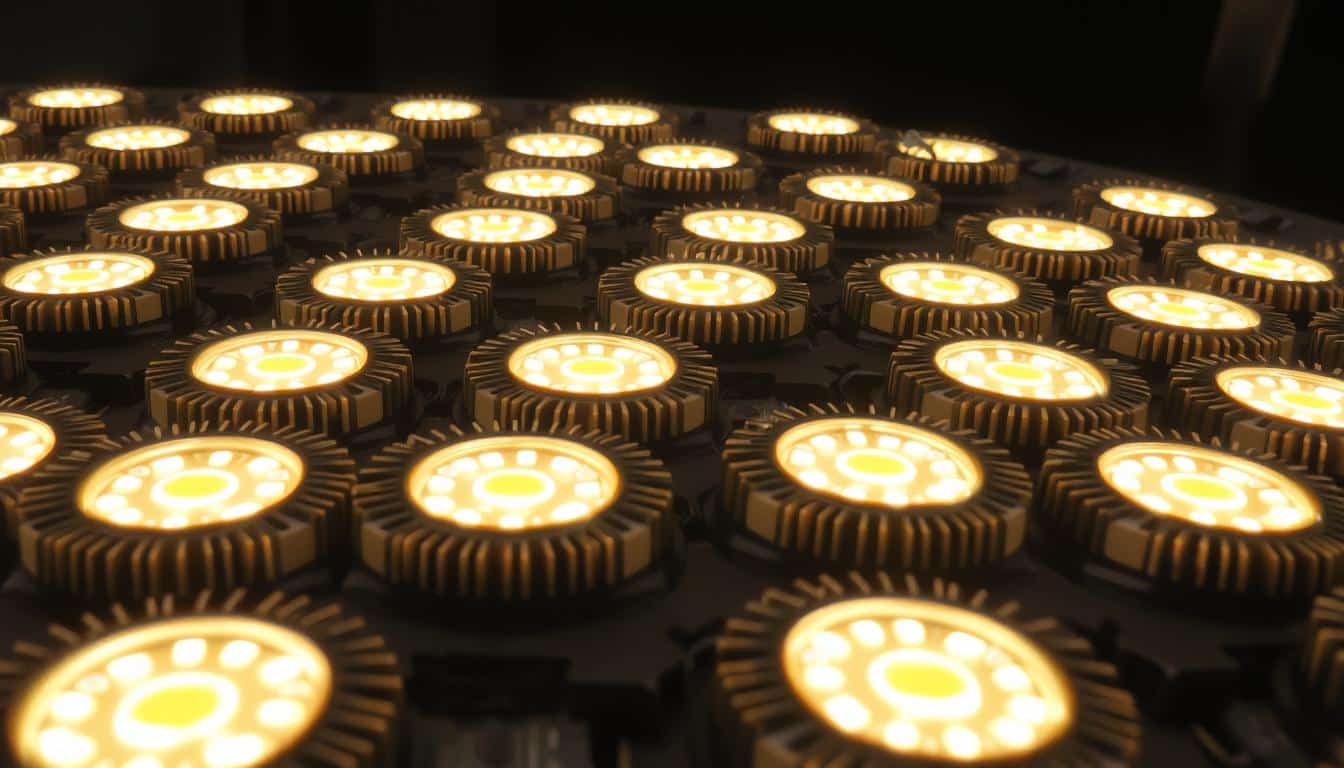
For LED street lights to work well and last a long time, they need the correct parts and materials. The quality of these parts has an impact on how well the system works, how long it lasts, and how much it costs.
Luminaires and LED Modules
LED street lights need LED modules and luminaires to work. The basis of the system is the LED modules, which provide the light. These modules are housed in luminaires, which also direct the light. High-quality ones make sure that the light spreads evenly, there is less glare, and less energy is used.
Brackets and Poles
The brackets and poles need to be sturdy and able to stand up to the elements. They have to deal with wind, rain, and very hot or cold weather. Most of the time, poles and brackets are made of steel or aluminum so they don’t rust or break in bad weather.
Wires and Connectors
LED street lights need cables and connectors to perform properly. Good cables and connectors make guarantee that power is supplied safely and efficiently and stop electrical breakdowns. Pick them based on the weather, the voltage, and the current.
Materials for Fixtures, Lenses, and Housing
The fittings, lenses, and housing materials are also very important. The fixtures direct the light, the lenses spread it out evenly, and the housing covers the inside. Materials should last a long time, be clear, and not be damaged by the weather.
Inspection & Testing Procedures for LED Street Light Fixtures
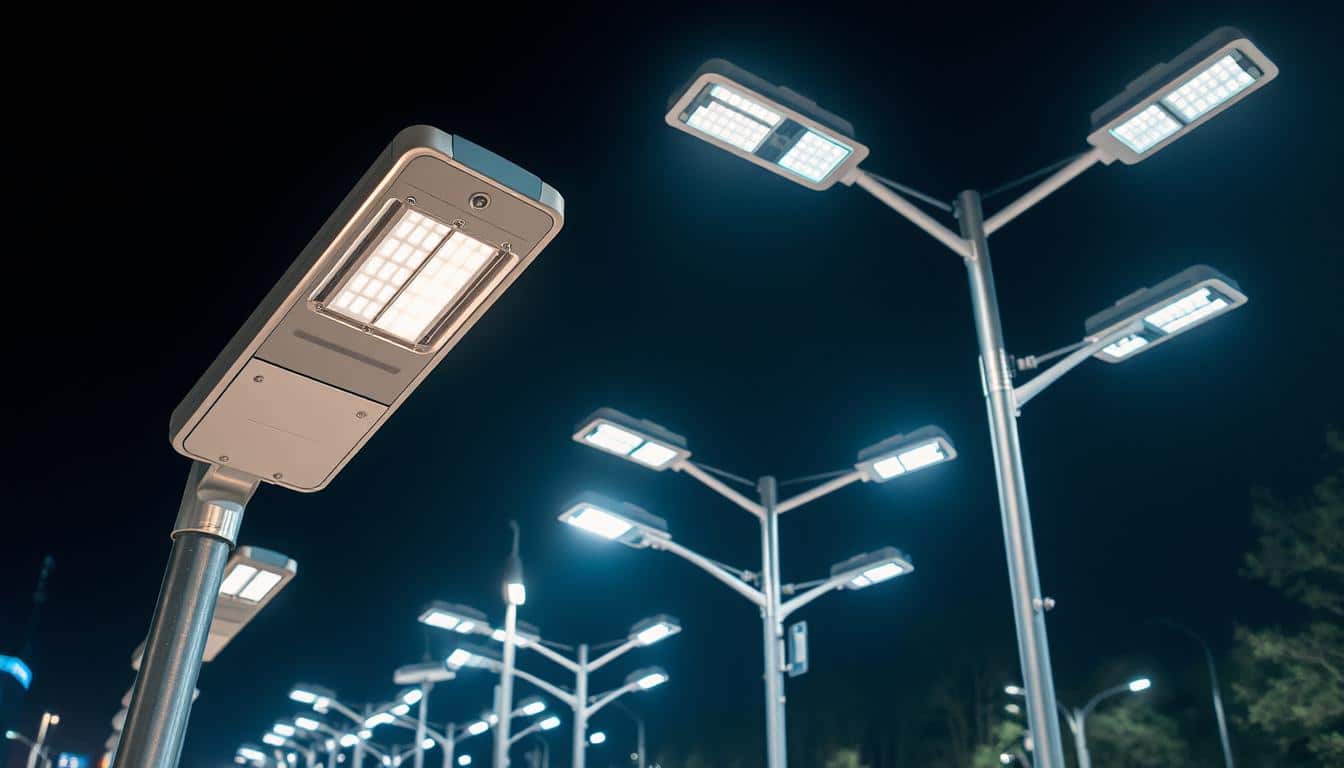
Making sure that LED street lights are of good quality is very important. This is done by following stringent rules for testing and inspecting. These processes are very important to make sure the lights meet and often surpass specifications.
Pre-Delivery Inspection
Before shipping, a pre-delivery examination is done. It looks for problems or flaws in the production process. The inspection checks the lights, poles, and other items to make sure they meet the agreed-upon standards.
- Check LED modules and lights by looking at them to see if they are broken or have any other problems.
- Checking the packaging to make sure it doesn’t get damaged while being shipped.
- Functional testing to make sure the lights work how they should.
Post-Delivery / Verification Inspection
A post-delivery or verification examination is done after the lights get there. This check makes sure that the lights weren’t broken when they were being shipped and that they match the requirements.
- Looking at the lights and poles to see how they are doing.
- Making sure that all the parts are there as ordered.
- Doing operational tests to make sure everything works.
How to Sample
The way samples are taken is an important part of the inspection process. It chooses a representative sample of lights to test in detail. This strategy finds problems without having to check every light.
If there are 1000 lights, for instance, 50 might be checked. This is based on a sampling plan that was made by standards or the needs of the customer.
Acceptance Tests (Routine & Type Tests)
Routine and type testing are both types of acceptance tests. Routine tests make sure that each light works. Type tests verify a sample’s design and performance under a range of scenarios.
| Test Type | Description |
|---|---|
| Routine Tests | Functional testing, visual inspection, and operational checks. |
| Type Tests | Performance testing under extreme conditions, longevity tests, and environmental tests. |
We promise that our LED street lights are of the best quality and performance by completing these steps for testing and inspection.
Maintenance and Lifecycle Considerations for Street Light Fixtures
Taking care of LED street lights is important if you want them to last a long time. Taking care of them on a regular basis helps them perform effectively and last as long as you want them to.
Preventive Maintenance
Checking and correcting things before they break is what preventive maintenance is all about. This entails cleaning LED street lights, verifying their connections, and ensuring sure they work properly. A research indicated that regular maintenance can lower energy use by as much as 10%.
Important things to do are:
- Cleaning lenses and lights on a regular basis
- Checking the electrical connections
- Looking for indicators of wear or damage
Replacement & Spare Parts
It’s important to have a plan for replacing parts and to have extra parts on available. You may need to replace LED modules and drivers a lot. To make sure they fit and perform correctly, you should only buy these parts from trusted sources.
A proper plan for replacing things can minimize maintenance expenses and keep services working smoothly.
Energy Efficiency & Cost Savings
People know that LED street lights save energy, but they need to be taken care of regularly to keep doing so. Cleaning and fixing them helps them use less energy. Experts explain, “Energy efficiency isn’t just about getting things going; it’s also about keeping them going.”
“The key to achieving energy efficiency is not just in the technology itself, but in how well it is maintained over time.” — John Smith, an expert on energy efficiency.
Smart or Adaptive Lighting Controls
Adding smart or adaptive lighting controls to LED street lights can help them use even less electricity. These devices change the amount of light dependent on how much traffic and light is outside. This uses less energy and makes the night sky less bright.
| Feature | Benefit |
|---|---|
| Adaptive Lighting | Adjusts lighting levels based on traffic and ambient light |
| Real-time Monitoring | Allows for immediate detection of faults or issues |
Cities can save a lot of money and have less of an effect on the environment by using these smart measures.
Cost and Energy Analysis for LED Street Lights
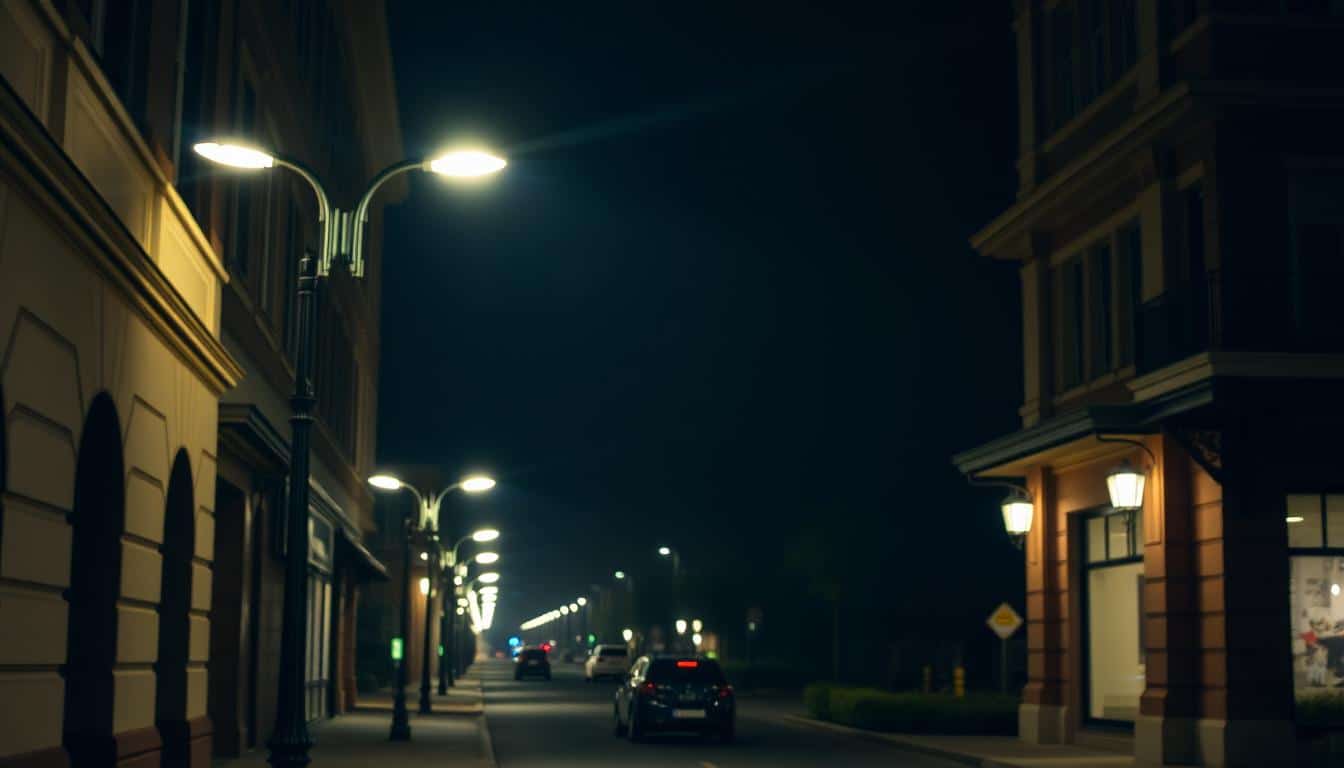
Over time, LED street lighting are a wonderful deal. You need to think about both the start-up costs and the total cost over their lives.
Initial Investment vs Lifecycle Cost
At first, LED street lights cost more than regular lighting. But they save money over time because they use less energy and need less work. LED street lights also last longer, which means you won’t have to replace or fix them as often.
For instance, LED lights are compared to lights that use high-pressure sodium (HPS). HPS lights could cost less at first. But they use more power and demand more upkeep.
Energy Consumption Comparisons
Street lights that use LED technology use extremely little electricity. They glow exactly as brightly as old lights, but they use a lot less power. In the long run, this will save you money on your electricity expenses.
- LED street lights consume up to 50% less power than HPS lighting.
- LEDs are more energy-efficient, which helps lower greenhouse gas emissions.
- Using less energy also puts less load on the electricity grid.
Return on Investment (ROI) and Payback Period
The return on investment (ROI) for LED street lights comes from the money saved on electricity and upkeep. The payback time varies on how many lights there are, how much electricity costs in the area, and how often they are used.
LED street lighting usually pay for themselves in 3 to 7 years. After that, the savings keep coming in, which adds up to a substantial return over the life of the LEDs.
Cities can make sensible choices by knowing how much LED street lighting cost and how much energy they use. They can weigh the expenses of doing things now against the savings and advantages to the environment in the long run.
Final Thoughts
Wholesale custom LED street lights from China, especially from well-known companies like Murcu, are the way of the future for environmentally friendly city infrastructure. LED street lights are a better investment than traditional lighting systems since they last longer, use less energy, and need less maintenance. China’s experience with mass production, customization, and following international standards means that cities and businesses may get reliable, eco-friendly, and affordable solutions that meet their needs.
As more and more people want cities to be greener, LED street lights will continue to be important for lowering carbon footprints, making public spaces safer, and lowering operating costs. By choosing Murcu’s wholesale and custom solutions, cities, developers, and businesses can confidently use modern lighting that strikes a balance between performance, durability, and environmental responsibility. This will lead to cities that are brighter, smarter, and more sustainable.
LED Street Lights FAQs
What are the good things about adopting LED street lights?
LED street lights use less energy and last longer. They are also easier to take care of. They also provide superior light and can be made to match your needs.
How do LED street lights stack up against other types of illumination, including HPS and CFL?
HPS and CFL lights utilize more energy and don’t last as long as LED lights. You may also make them better for your needs and they give off more light.
What are the most important things to think about when making LED street lights?
Street lighting design, where to put the lights, and what kind of poles to utilize are all important things to think about. You also need to consider about the wiring and the rules for the quality and longevity of the light.
What do LED street lights need to do to work?
LED lights have to meet regulations for how bright they are, how well they illuminate, and how evenly they do so. They should also be able to block glare and last a long time. Standards for electrical and mechanical systems are equally important.
What parts and materials go into LED street lights?
LED lights are made up of poles, cables, fixtures, and LED modules. The system’s reliability and efficiency depend on how good these parts are.
How do people check and test LED street lights?
Before and after delivery, LED lights are verified. They also have to pass testing to make sure they fulfill quality and performance criteria.
What do you need to think about when it comes to the upkeep and lifespan of LED street lights?
Regular checkups and replacing parts as needed are part of maintenance. Smart controls can also help you save money and energy over time.
What effects do LED street lighting have on energy use and costs?
LED lights utilize less energy than older lights, which saves money and is better for the environment. They also last longer, which means you won’t have to buy new ones as often.
What are the pros of adopting smart or adaptable lighting controls for street lights?
Smart controls change the amount of light to save electricity. They also let you monitor and regulate things in real time, which helps lower costs.
Do you know of any case studies or success stories about using LED street lights?
Yes, a lot of projects indicate that LED lighting save money and energy. These stories talk about what they learned and what went well.
What is the usual return on investment (ROI) for LED street light projects?
The return on investment (ROI) changes depending on how much energy is used, how much maintenance is needed, and how much the project costs to start. But a lot of projects save a lot of money and have a good return on investment.
Can LED street lighting be made to fit certain needs?
Yes, you can customize LED lights for their look, performance, and function. Many Chinese companies sell LED street lights in bulk and on demand.


